With this class of wide receivers I think it’s really about what your taste is and what you need on your roster. If you just look at the top three guys you have a huge target to bail his quarterback out, a precise route-runner who hurts defenses after the catch and a true burner, who can get by anybody with his speed. I don’t have any doubt all three of them will go in the first round. After that it gets a little more complicated. The question is: Do you trust production or do you solely look at potential? I don’t count in off-the-field stuff in my rankings, I only look at talent and competitiveness.
I go at least 20 to 25 prospects deep in my evaluations at every position. So if there are any players you’d like to hear my opinion about, just let me know in the comments.
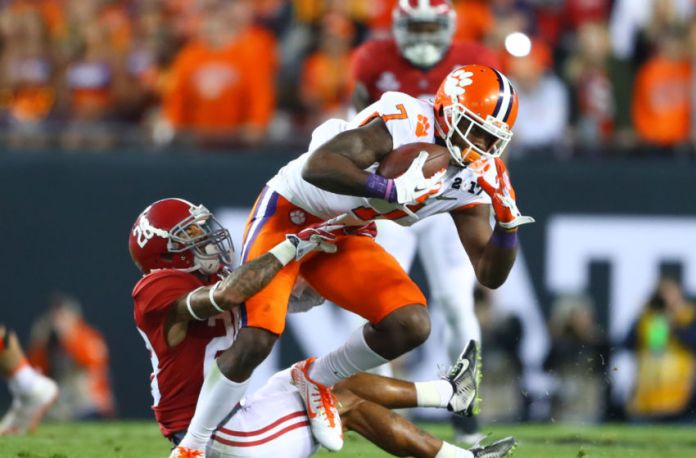
1. Mike Williams, Clemson:
After showing a ton of promise as a sophomore (1030 yards), Williams missed almost all of 2015 due to a gruesome neck injury before transforming into the best receiver in college football last season. He plays huge when the ball is in the air, making 50-50 balls look more like 90-10 balls, with the biggest ones coming in this year’s National Championship Game. He is unbelievable along the sideline sliding to the ground or defeating cornerbacks on back-shoulder throws. The Clemson star can work all levels on the field and really adjusts well to the ball in the air. During his collegiate career he was often grabbed when he won and drew a multitude of flags. He also has shown a bunch of clutch catches even on tipped balls. Once he has the ball in his hands he runs like a wild horse. I feel like he doesn’t use his size enough as a blocker and he can get sloppy with his route-running at times. He will have to release from press quicker and to me is just too loose with the football at times because he doesn’t think he can’t be brought down anyway, but he frustrated opponents much more than anybody else.

2. Corey Davis, Western Michigan:
After three straight seasons of 1400+ yards and more than 15 touchdowns on average the small-school product enters the draft as one of the most prolific receivers in recent years. At 6’3’’, 215 pounds he is a very crisp route-runner, who understands it’s not always about running full-speed, but rather uses different gears in his routes. He can line up outside and in the slot, is outstanding at tracking the ball down the field and fights for it in the air. Davis is a chain-mover, who always works back towards the football and is slippery in the open field. Not only can he outrun defenders, he has also caught a ton of underneath passes and consistently earned extra yards. Despite his prowess as a run-after-catch specialist he only had one fumble during his entire collegiate career. During his time at Western Michigan he had 27 games of 100+ yards receiving and averaged more than a TD a game. What I love about him is that he is a great blocker for his teammates, but he’s had too many focus-drops (11 in 2016 alone). He isn’t super-quick and had free releases off the line a lot of times, but he is ultra-competitive and dominated the MAC competition. To me is more of a 1b in this class.
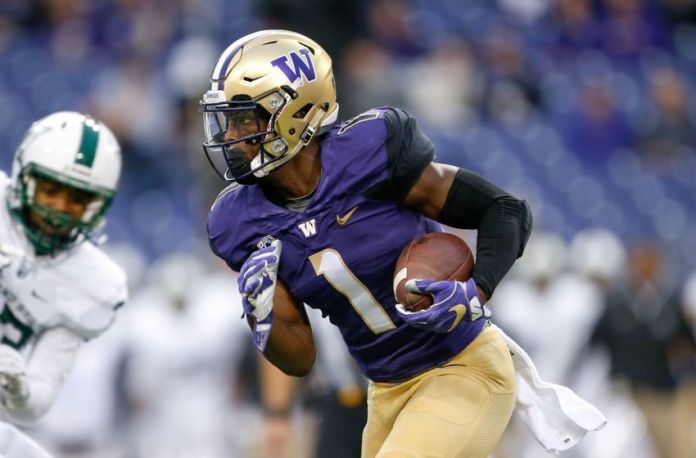
3. John Ross, Washington:
The new king of the 40 (4.22) is vertical nightmare, who leaves DBs standing with hesitation (six 50+ yard catches in 2016). He is sudden out of his breaks and has worked hard on his route-running- He can’t be left space towards the sideline, where he ate people up, resulting in 17 touchdowns as a junior. The Washington motioned him around a lot and he was a mismatch in the slot, constantly drawing flags. Ross is amazing at tracking the deep ball, therefore has to be given respect due to his speed and took advantage of that on curl and comeback routes. He will provide instant impact as a kick returner (24.4 yards on average and four TDs). He wasn’t asked to block a lot, but rather was used as a decoy. The speedster is a superb athlete, but doesn’t have the desired measurements (5’11’’, 190 lbs.) or muscular frame, which could result in speedy corners to not be afraid to run him into the boundary. He lacks the strength to break tackles and has had major injuries on both his knees, but if his medicals check out fine and things are kept simple in terms or keeping the route-tree small he could be game-breaker right from the start.

4. Dede Westbrook, Oklahoma:
Not only is Dede lightning-quick to dish out ankle-breaking double-moves, he has game-breaking speed. During his time at Oklahoma it was just a question of time – at some point got behind the defense. He plays much bigger than his size would indicate and he oftenlooked like Antonio Brown by how he destroyed defenses. He is a huge threat from anywhere on the field – deep shots, reverses, screens, etc., but at the same time has very reliable hands and fights like a 250 pound back when people try to bring him to the ground. Westbrook struggled vs. Ohio State’s excellent corners because they played him very physical. He lacks the desired height and frame, but he wins with separation and has done so every week in his last season other than the aforementioned OSU game. He has some experience as a returner and could develop into of the more dangerous return men in the league. He will slide down some draft boards due to domestic violence incidents against the mother of his children in 2012 and 13 and he kind of is a one-year wonder, but he was spectacular in that one season.
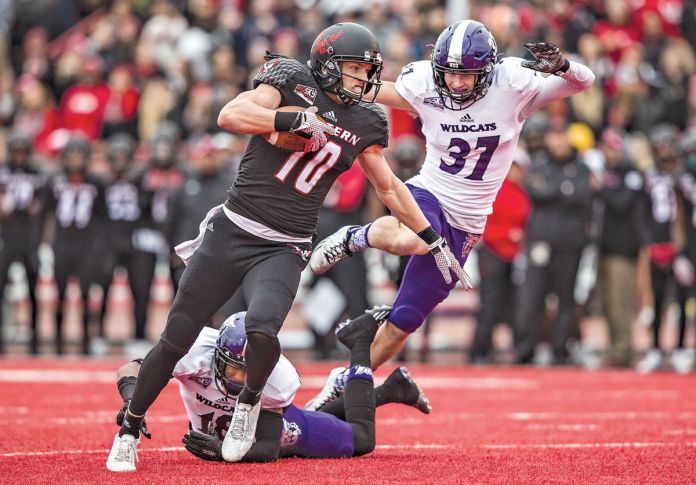
5. Cooper Kupp, Eastern Washington:
This guy absolutely dominated the FCS competition (6464 yards and 73 TDs in 52 career games), but he was even better against his two biggest opponents Washington State and Oregon with 200+ yards and three TDs in each game. He is a big vertical target, but also really quick out of his cuts for his size. Kupp has an innate feel for how to run routes and looked unstoppable in Senior Bowl practices, not really losing a single rep all week. If I had to compare him to an NFL player I’d say he looks like a better version of Eric Decker. He has the strength to run through tackles and the speed to run away from everybody. In college he showed he can handle a heavy workload and he climbs the ladder to bring in overthrows. He was lined up primarily in the slot at EWU and will have to learn how to win on the outside, as he takes too much time to stop and run comeback-routes. The FCS’s all-time leader in receptions, receiving yards and touchdowns obviously had lower-level competition, but he answered all my questions in Mobile and by what he did against Marcus Peters and Sidney Jones of Washington. He can play.
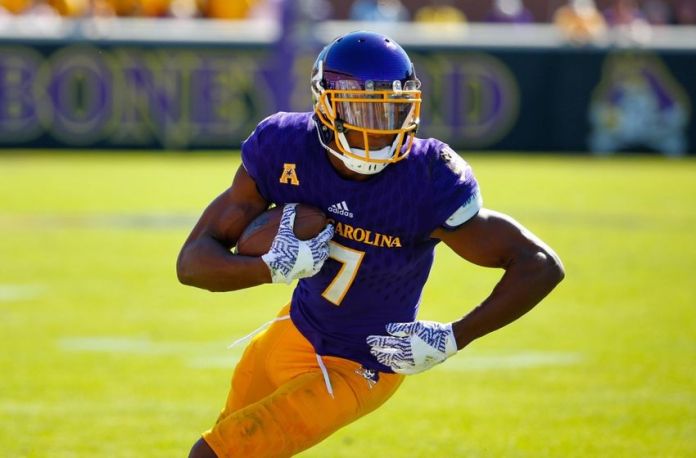
6. Zay Jones, East Carolina:
This was the second receiver at the Senior Bowl who left me in awe. He has more catches than anybody in FBS history (399), simply catches everything thrown his way and doesn’t let the ball get into his body. He tracks the football very well and is tough as nails over the middle. He displays a great catch-radius and at 4.45 in the 40 he has much more speed than scouts give him credit for. He was always well respected by the Pirates’ coaches and players due to hard work and high-end character on and off the field. His incredible catch numbers were in large part due to the offensive scheme and the huge amount of targets per game. He presents a small frame and doesn’t have the wiggle to compensate that, but he proved to me he can beat man-coverage by the best CBs at Senior Bowl week and I have no doubt he will make plays at the next level.
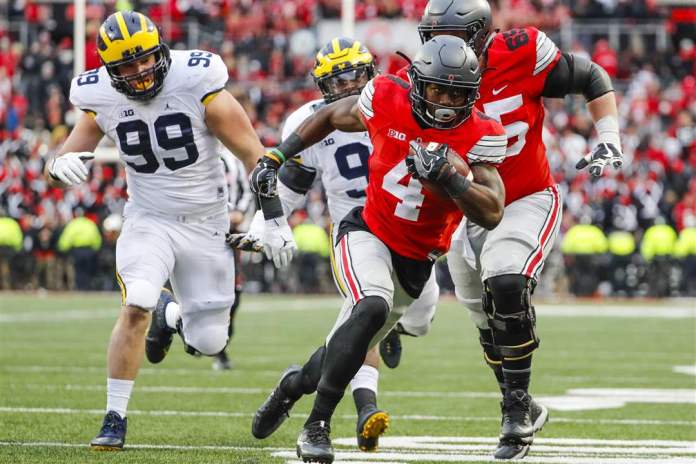
7. Curtis Samuel, Ohio State:
This dude just has an X-factor to him. He is very versatile off the slot on sweeps, bubble screens or shovel options. He is basically a running back lined up as a receiver, but he can certainly handle a bunch of carries lined up in the backfield, resulting in more than 1600 yards from scrimmage last season. Samuel can stop on a dime and then accelerate again quickly. He has a feel for finding voids in the coverage, shows sprinter speed and always is a threat to take it the distance. He dances around too much in the backfield as a running back, is not as natural a receiver as some other guys in this draft and benefitted from being moved around a lot to have space, leading me to think he could be shut down by number one cover men who don’t let him get into his routes comfortably, but he is an offensive weapon who can be used in a variety of ways. Once again Ohio State’s pro day featured crazy talent with three potential top-15 picks, but it was Samuel who stole the show in his positional workout.
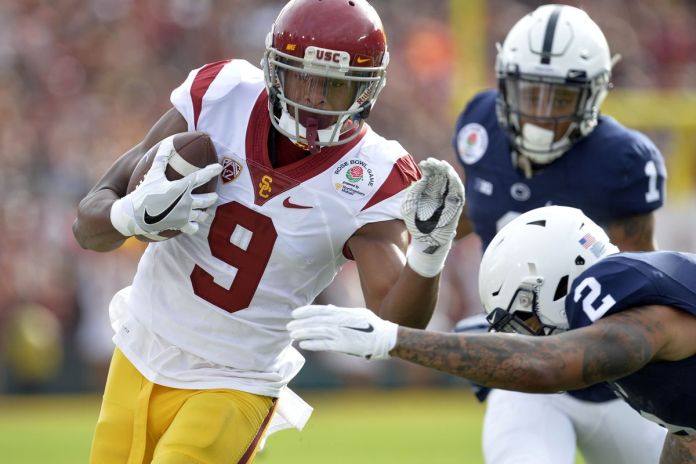
8. JuJu Smith-Schuster, USC:
This guy is kind of a mystery to me. In this year’s season opener he had one catch for nine yards, then in the middle of the season he has a stretch of three straight 100-yard performances (and one with 98) before he caught two balls for 10 yards in a 45-20 win over Oregon. His potential is off the charts, but he can’t quite perform up to it consistently. He showed a heavy decline in his production from his sophomore to his junior year, due to more attention from defenses and a lingering back injury. Here’s what I know: Smith-Schuster has great size, strong hands and outstanding body control, but he also lacks the speed and suddenness to separate on routes. He loves football and comes down with a bunch of contested catches, but I need to know how much injuries held him back last season and why he completely disappeared at times in games, although I saw tape of him where I thought he was definitely open. Based on his natural abilities he’d a first-rounder, but he’ll need time to recover and work with his receiver coach to make an impact in the league.
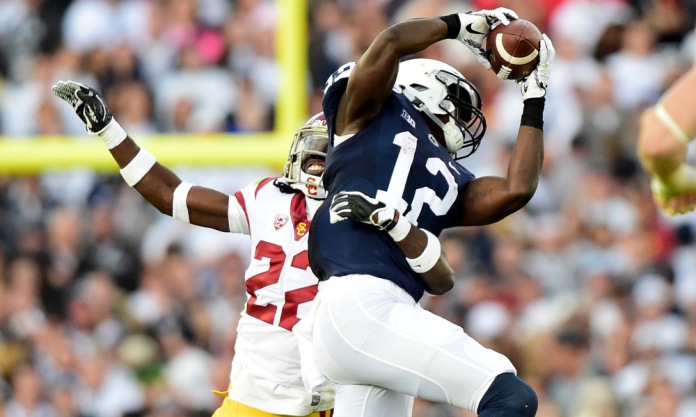
9. Chris Godwin, Penn State:
This guy has amazing hands and can literally take the ball away from defenders on jump balls, but he is even better at boxing out and using his big body to get into position. Even though he plays really big he has impressive speed to outrun defenses and he averaged more than 16 yards per catch as a sophomore and junior. Another thing I like about Godwin is the way he keeps his feet moving through the contact. He played huge against Adoree Jackson in the Rose Bowl, as long as the USC corner was in the game. To me he has to erase some of the focus drops on easy passes and be more aggressive as a blocker, but with a 4.41 in the 40-time he has erased my doubts about how his big-play ability will translate to the next level. You can count on him to perform at his best in the biggest games, as he had more than 150 yards receiving on average in his three bowl games as a member of the Nittany Lions.
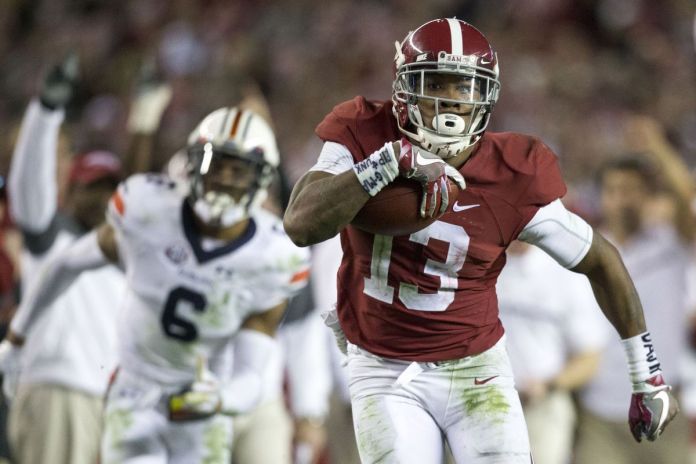
10. Ardarius Stewart, Alabama:
To me the most underrated receiver in college football over the last two seasons was Alabama’s Ardarius Stewart. He has deceptive speed to blow by the coverage and is very dangerous as a runner to the edge. He was mainly used on sweeps and run-after-catch plays in Bama’s offense, but he has shown complex pro-routes and I don’t have any doubt he can do that in the NFL. When he has the ball in his hands he loves to bring the punch to the defenders and doesn’t mind giving up his body. Unlike most college receivers nowadays he really takes pride in his blocking and can deliver blows on DBs. His versatility also shows up on special teams as a returner. As a member of the Crimson Tide he always was a number two receiver, simply because Bama has had outstanding WR1s since Julio Jones. Still, I think Stewart is a true no. 2 receiver and will be at his best in that role. His hands could be softer and his routes more precise, but he is an extremely tough player, who will make his OC very happy.
Just missed the cut:
Malachi Dupre, LSU:
The former Tiger is a long-strider who can be a threat vertically, but also work in the open space and burn coverages. He creates separation at the top of his route, especially on comeback and curl routes, and he makes catching the ball look easy, even if the placement isn’t on point. Dupre has a sense for making things happen after the catch, running it very physically. He didn’t put up big stats because he played in a very run-heavy system with two monster backs and poor QB play, but he averaged 16.4 yards per catch during his time there. He has the tools to be one of the next great LSU wide receivers like Odell Beckham Jr. and Jarvis Landry (well, maybe a tier underneath them), but he needs to refine his route-running and play a little tougher over the middle. I would also like to see him commit more as a blocker. I think he could really flourish in a number two role.
Ryan Switzer, North Carolina:
This kid is an outstanding route-runner who does a great job at coming back to the football. He has NBA-level foot-quickness and shake-and-bake in the open field. He is definitely quicker than fast and doesn’t present a very big target, probably limiting him to a pure slot role, but I’m fine with that because he wins with separation. Switzer had a great start to Senior Bowl week, but banged up his ankle and couldn’t quite perform at the same level the rest of the way. My only real concern is that he can struggle against press, which NFL nickels love to play, but he has shown at UNC that he can carry a heavy workload and he adds some value as a punt returner.
Chad Hansen, California:
Nobody even knew this guy’s name nationally before last season, but he jumped onto the scene as Cal’s number one receiver in his sophomore year, recording 92 catches for 1250 yards and 11 touchdowns, despite missing two games because of an ankle injury. He’s a tall vertical target, who does a nice job shielding defenders away from the ball with his large frame. He adjusts to the ball in the air naturally and doesn’t mind fighting for it. The concerns for me are that he is a very upright runner with mediocre acceleration from a full stop and he doesn’t consistently create a lot of separation. However, he was asked to run a variety of routes for the Golden Bears and beat people like crazy on deep balls.
Isaiah Ford, Virginia Tech:
Ford’s speed puts a lot of stress on defenses, but he’s also dangerous on slants and deep posts. He is very quick off the ball to elude punches in press, even though he doesn’t use his hands well enough yet. Sometimes you simply have to put the ball in his hands and he will make things happen. He shows good hand-eye coordination on jump-balls and keeps laser-focus throughout the catch. Ford also displays outstanding awareness along the sideline, plus the according body control to bring in catches. He often played limited snaps, but he’s usually pretty reliable, even though he doesn’t have the most natural hands, often having to double-clutch catches. Too often he elevates and waits for the ball to come in his hands instead of attacking it at the highest point and he doesn’t quite put enough effort into selling plays if he’s not one of the primary targets. I’m glad he improved his 40 from 4.61 at the combine to 4.52 at his pro day, but for a speedster he didn’t clock good enough for me to put him in the top ten.
Amara Darboh, Michigan:
Coming into the 2016 season people thought Jehu Chesson would be Michigan’s number one receivers, but Darboh clearly outplayed him, in my opinion. He has NFL measurements and simply understands how and when to work back to his QB. He’s fearless over the middle with the concentration to bring in catches off the ricochet, often diving to bring in tough passes. Not only does he run smooth routes, he is also a willing blocker. Darboh only has average speed, struggles at times with poor ball placement, especially when thrown behind him, and only had two 100+ yard-games on a mediocre passing offense last season, but he has often come up with big plays when his team really needed him.
Right behind them:
Artavis Scott (Clemson), Noah Brown (Ohio State), Josh Reynolds (Texas A&M), Trent Tayler & Carlos Henderson (Louisiana Tech), KD Cannon (Baylor)


Hansen had better PAC 12 production in 10 games than Ross had in 15. Playing in a more pro style offense. Both are one year wonders, but Hansen is sturdier and more versatile. Chad is the better receiver.
LikeLike
I wouldn’t say either one of the two played in a pro-style offense, Hansen was just asked to run more different routes. He is bigger and can shield the ball away from defenders, but he stays tall throughout plays. While Ross lacks the size to survive in the middle of the field he has the quickness to get in and out of breaks and adds another gear to what Hansen has.
LikeLike
Speedy Noil from Texas A & M will blow away the majority of the guys you have listed as a pro. He’s a better all round athlete than anyone mentioned, and tougher as well.
LikeLike
I really thought about putting Speedy among the group of “Right behind them”, but to me it came down to this: He’s a much better athlete than football player. He doesn’t track the ball down the field very well and I question his overall football character. If he failed to meet expectations at the college level, why would he be able to in the pros?
LikeLike
Did Zay Jones go to Eastern Washington or East Carolina?
LikeLike
East Carolina. I mistakenly tipped Eastern Washington next to his name as well. Thanks for letting me know!
LikeLike